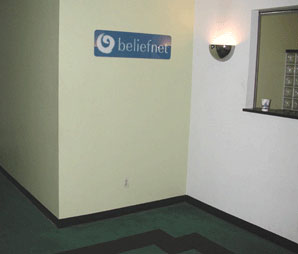 |
|
| BEFORE: Beliefnet's lobby entrance seemed little more than a humble mail room. |
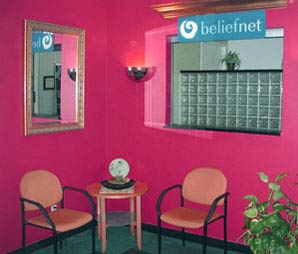 |
|
| AFTER: Our new lobby is not yet a showplace, but it's the talk of our building! |
When I arrived to help edit the website in mid-2003 -- coming in as a veteran magazine writer and wife of co-founder/CEO Steven Waldman -- the office still bore visible scars of the company's near-demise. Meetings were held in a conference room with dirty white walls, stained orange chairs, and a frayed green and black rug. Mismatched desks and chairs, abandoned computer monitors, and a broken Xerox machine occupied one corridor like hulking buffalo on a ravaged plain. You could almost hear the cruel wind howling.
I found myself drifting into worried thoughts. Could we truly succeed in this place? I forced the mantra: "It doesn't matter. It doesn't matter." I brought in a little Indian lamp from home, placed it on my desk and tried to carry on.
But it did matter. I knew that the look, feel, organization, and yes, "energy" of an office can radically affect mood, health, and success. As the newest editor in the office, I didn't have a lot of say but since I'd been hired for my knowledge of the 'spirituality' beat, it seemed to me that Beliefnet, back on its feet, needed an energy-boosting office redesign. I turned to Nancy SantoPietro, an internationally known Tibetan Black Hat Feng Shui expert. After some negotiation (she waived her $1800 day rate with the understanding that we'd publish an article -- this one -- about the experience), she agreed to help us out.
Feng Shui (which literally translates to "wind" and "water,") is the hot interior design method derived from ancient Chinese spiritual principles that govern the flow of energy, prosperity, and happiness. In recent years the ancient art has caught on like wild fire, fueling hundreds of small design firms, and becoming the subject of workshops the world over.
So I was relieved when Nancy and her assistant Diane Hoffmann showed up, both nice-looking women wearing vibrantly colored clothes and discreet necklaces of crystal beads. Nancy herself sported a streetwise swagger and a slight Brooklyn accent.
But that's where Nancy's common touch ended. In my lifetime, I have met people I felt had direct pipelines to the divine. But whoa, Nancy! It was like she had a beautiful crystal chandelier rotating inside her. Raised a Roman Catholic, she had been a student of Buddhism for many years when in 1989 she became one of the first few female Westerners trained by H.H. Professor Thomas Lin Yun Rinpoche, GrandMaster and Spiritual Leader of the Tibetan Tantric School of Buddhist Black Hat Sect Feng Shui. While honoring the Rinpoche's traditional teachings, she blends in skills gained from her earlier 10-year career as a psychotherapist. Every summer, students flock to Brooklyn to train in her "Accelerated Path" method of Feng Shui and Chakra Energy systems. She is also the author of two popular Feng Shui books.
When Nancy wanted to talk awhile before touring the office, I assumed she meant discussing what furniture we were going to move where. Instead, she asked each member of Beliefnet's management team to speak about their role with the company. Acting more like a spiritually hip corporate shrink than an interior designer, she then gave a penetrating analysis of their talents, health status, and energy levels. Our jaws dropped at her ability to say things about us that had taken us years to figure out. She divined these insights, I've since learned, by analyzing our faces and our chakras -- those seven rotating energy centers within the physical body. The main problem, it seemed, was in the area of our corporate solar plexis which had been depleted from overwork.
I embrace this stuff lock, stock, and barrel -- or maybe bell, book, and candle. But after gutting out a tough year, the management team can't be blamed for receiving all this with some skepticism. To their credit, they remained open to Nancy's blunt insights. Our office's "chi" or life force was very low, she said, and the staff was receiving little sustenance from its work environment. Chi energy, by Eastern tradition, is the vital essence of divine life, the energy one feels on a beautiful beach. Before moving through the office, Nancy did give us one bit of good news: The 14 hideously orange chairs, retained mostly because no one would buy them during the company's bankruptcy, actually helped us survive. Orange is the color of family, Nancy explained. "The orange chairs saved you."
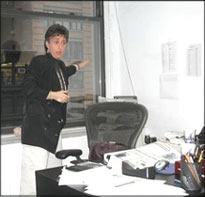 |
|
| Nancy SantoPietro indicates where she wants plants suspended at the window. |
The walls throughout the rest of office -- all white -- remain a problem. The color white doesn't "hold chi" very well, so with all that white our energy would tend to bounce about aimlessly. In a perfect world, Nancy recommended painting all the white surfaces pale yellow. She also suggested that a wall that runs the length of our office be painted the same deep burgundy red as the entrance hall. This would activate the areas of Feng Shui that oversee our success, visability, finances, and staff relationships. This, she said, would be the most energizing change we could make to the entire workspace. Sadly, while Nancy was admirably frugal in her suggestions generally, that wall must be 70 feet long and the burgundy takes four coats, so as of this writing, we're still saving our pennies and looking at white.
Nancy told us to furnish the newly painted entrance with two extra orange chairs we had lazing around, and advised us to bring a small recirculating fountain from inside the office out to the foyer, since water provides a favorable, lively element that builds chi and increases financial energy. Also, at her instruction, we bought a $65 sacred flute made out of a single piece of bamboo, festooned in tassels and ribbons, symbolic of a sentry standing guard over us while also raising the positive energy flow of all who enter. She also recommended hanging wind chimes throughout our space -- not to make soothing music, but to hang silently, unblocking energy and redirecting its flow into a more conducive pattern like an acupuncturist's needle.
To involve all our senses, Nancy sent us to an essential oil expert who mixed up a "Beliefnet Blend" of therapeutic-grade energizing citrus oils. We also bought a professional-grade scent-diffusing machine. This has been mostly wonderful but we do have to trade off being "mindful" and remembering to turn the darned thing off at night. Aromatherapy fosters better team work, I guess.
2. LIVEN UP THE MONEY WALLS. According to the Feng Shui bagua (an eight-sided map, based on the Chinese oracle of the I-Ching, with which the consultant maps out spiritually satisfying spaces), the left hand wall of any space as you enter governs finances. A mirror placed on a left hand wall opens up this financial realm. From a Feng Shui perspective, Beliefnet's foyer made us especially inhospitable to greater financing since that left hand wall jutted out quite rudely. A-ha! A rounded wood molding to soften the jutting corner and a large gilt-frame mirror on that wall will make us appear more welcoming to visitors and those bearing gifts. Also, left hand walls in the individual offices of those handling money -- like our Finance Director, for instance -- were given mirrors to keep financial chi contained and directed.
3. FACE THE DAY AND EVERYTHING ELSE. It's basic feng shui wisdom that desks should never be aligned directly with a door, and workers should always be facing the door as visitors enter. At Beliefnet, the most obvious desk in an unfavorable position belonged to the co-founder and CEO, whose back faced the door, just asking to be stabbed, spiritually speaking. She advised us to move his desk so he'd face the door, but she also cautioned that desk position changes can have profound repercussions and that Steve should move his desk only when he felt ready. She told us to place plants in strategic positions - a tall corn plant would be excellent, to give his "woody" temperament some support. Also, she suggested painting the wall behind Steve the bold burgundy red of the entrance hall (another task we haven't yet managed).
Steve moved his desk into the preferred position right away, had disagreements with colleagues the next day, then came down with a terrible, awful hacking cold that lasted three weeks. A cleansing? A release? There's no telling. He seems fine now -- and more formidable than ever.
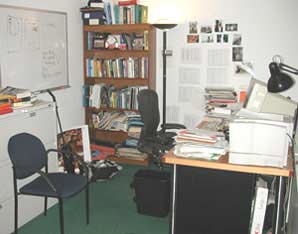 |
|
| BEFORE: Steve Waldman's office looked like the messy domain of a typical journalist. |
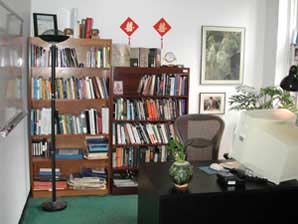 |
|
| AFTER: Though the back wall is supposed to be painted burgundy red, Steve's new desk position alone puts him in a "power" position. |
4. GET PROTECTION FROM THE EMFs. The florescent light boxes suspended over the editorial team's heads are at best, unpleasant to work under, and at worst, really bad for our bodies long-term. They are hung much closer to our bodies than most florescent fixtures and, according to Nancy's handy-dandy Electro-Magnetic Field (EMF) monitor, emit dangerously bad vibes. Nancy suggested turning them off as much as possible, and to consider getting rid of them.
So remedial was our feng shui that Nancy ended up donating a second day of her time, but once she departed, we immediately made the easiest changes, and received rave reviews from a grateful staff. Then came the longer slog, and the realization that it would take more time and more money to complete the whole redesign. President Sujay Jhaveri and Finance Director Toni DeMarco were wonderfully supportive of the project until we received a painting bid of $12,000, when their enthusiasm waned.
Cost was not the only consideration in how -- or whether -- to implement all of Nancy's changes. Beliefnet's staff, like our website audience, is composed of people of many backgrounds and faiths, and some might feel -- incorrectly, I think -- that Feng Shui's precepts clash with their own. There is also the matter of taste. Nancy's decorative touches -- like the four-inch-high Chinese "double happiness" signs -- are decidedly Asian, and perhaps not everyone's cup of tea. Everyone likes the idea of there being more artwork, but which particular style to choose? Would posters with Eastern spiritual themes alienate traditional Christians? Would classical religious art disturb our "spiritual but not religious" visitors? And of course some staffers have trouble taking the whole thing seriously -- like the wise-guys in the tech department who keep doodling a happy face on the little rearview mirror I added to the computer monitor of a woman whose back faces her door.
The hardest sell remains my husband the CEO. "I can't let you hang that over my head!" he said as I stood before him with a golf ball-sized crystal in hand. "What if some potential investor sees it?""Hush up," said I as I stood on a chair. "No one will notice."
Enter Executive Editor Elizabeth Sams. "Ouuuuu, nice crystal," she said.
"Shhhhhh!" I hissed, failing to silence Steve's groans.
The crystal's still up there. But the company "altar" -- a wicker tray Nancy told us to place near the entrance where employees have left small shells, stones, flowers, figurines, and written hopes or prayers in envelopes -- has a sweet presence, and I daresay, it must touch even the people who haven't left anything on it. It's a reminder that we are not run-of-the-mill business folk and cynical journalists.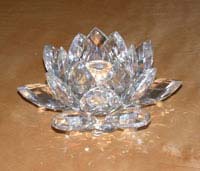 |
|
| This crystal lotus radiates good feelings from the center of our conference table. |

